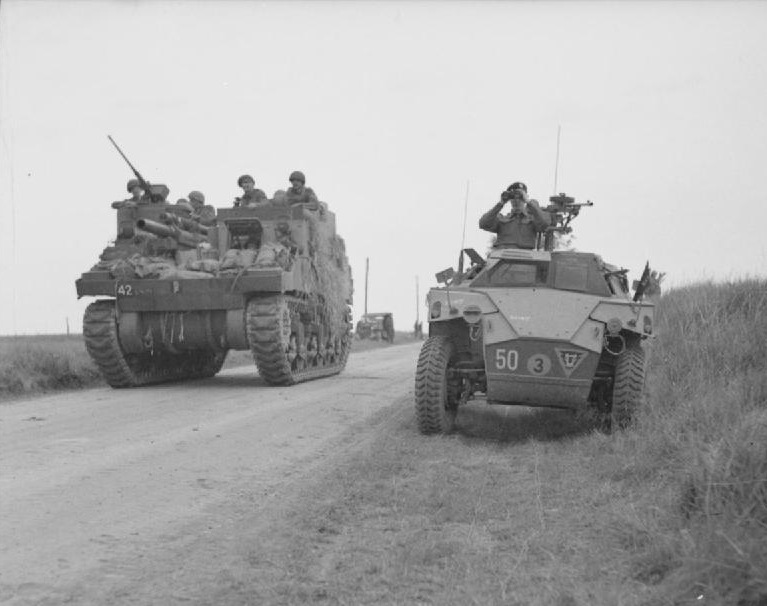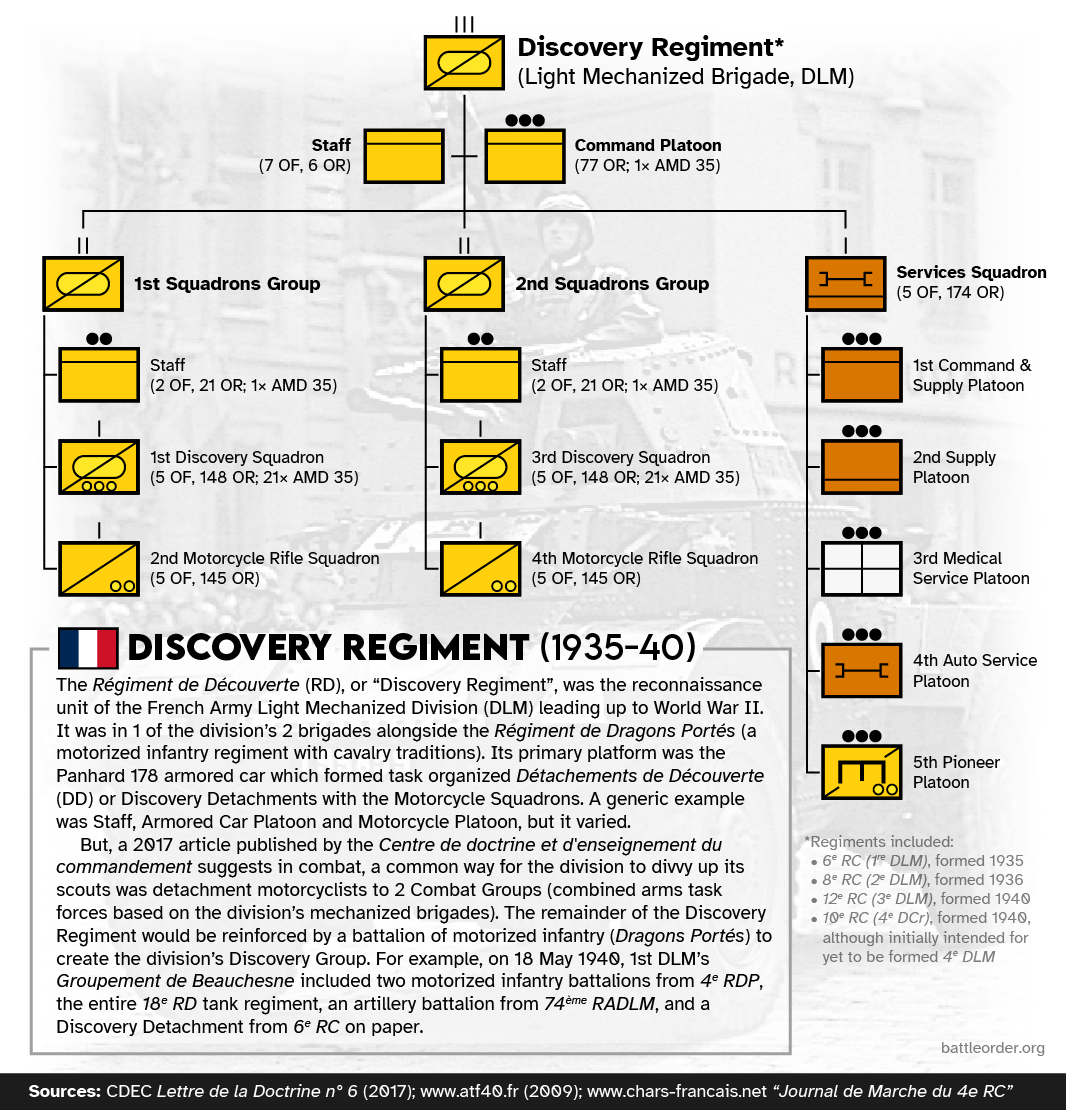|
2nd Armored Division (France)
The French 2nd Armored Division (), commanded by General Philippe Leclerc de Hauteclocque, Philippe Leclerc, fought during the final phases of World War II in the Western Front (World War II), Western Front for the liberation of France. The division was formed around a core of units that had fought in the North African campaign, and re-organized into a light armored division in 1943. The division embarked in April 1944 and shipped to various ports in Britain. On 29 July 1944, bound for France, the division embarked at Southampton. During combat in 1944, the division liberated Paris, defeated a Panzer brigade during the armored clashes in Lorraine, forced the Saverne Gap and liberated Strasbourg. After taking part in the Battle of the Colmar Pocket, the division was moved west and assaulted the German-held Atlantic port of Royan, before recrossing France in April 1945 and participating in the final fighting in southern Germany, even going first into Hitler's "Eagle's Nest" (America ... [...More Info...] [...Related Items...] OR: [Wikipedia] [Google] [Baidu] |
Cross Of Lorraine
The Cross of Lorraine (), known as the Cross of Anjou in the 16th century, is a heraldry, heraldic two-barred cross, consisting of a vertical line crossed by two shorter horizontal bars. In most renditions, the horizontal bars are "graded" with the upper bar being the shorter, though variations with the bars of equal length are also seen. The ''Lorraine'' name has come to signify several cross variations, including the Patriarchal cross with its bars near the top. The Cross of Lorraine came to the Duchy of Lorraine via the Kingdom of Hungary in the 15th century. Similar two-barred cross symbols prominently feature in heraldry from Poland, Lithuania and Belarus. Its ultimate origins are from the crozier of an Archbishop. The Cross of Lorraine was used as a symbol of Free France during World War II and was earlier used by French patriots to signify desire to reclaim provinces lost to Germany in the Franco-Prussian War. Design The Cross of Lorraine consists of one vertical and ... [...More Info...] [...Related Items...] OR: [Wikipedia] [Google] [Baidu] |
M7 Priest
The 105 mm howitzer motor carriage M7 was an American self-propelled artillery vehicle produced during World War II. It was given the service name 105 mm self propelled, Priest by the British Army, due to the pulpit-like machine gun ring, and following on from the Bishop and the contemporary Deacon self-propelled guns. Design and development During the early stages of World War II, US Army observers realized that they would need a self-propelled artillery vehicle with sufficient firepower to support armored operations. Lessons learned with half-tracks (such as the T19 howitzer motor carriage (HMC) with a 105 mm howitzer on the M3 half-track chassis) also showed that this vehicle would have to be armored and fully tracked. It was decided to use the M3 Lee chassis as the basis for this new vehicle design, named T32.Bishop, p. 120. The pilot vehicles used the M3 chassis with an open-topped superstructure, mounting an M2A1 105 mm howitzer, with a machine-gu ... [...More Info...] [...Related Items...] OR: [Wikipedia] [Google] [Baidu] |
3rd Marine Artillery Regiment
The 3rd Marine Artillery Regiment () is the heir to the 3rd Marine Artillery Regiment created in Rochefort by Napoleon Bonaparte's consular decree of May 13, 1803, the 3rd Colonial Artillery Regiment, then the 3rd Marine Artillery Regiment. The 3e RAMa has been present in either a constituted corps or isolated unit since 1803, on almost all the battlefields in which France has been engaged. The regiment was founded in a third operational phase in 1943. Creation and different nominations * On December 1, 1902 : 3rd Colonial Artillery Regiment at Toulon. * On January 1, 1924 : 310th Colonial Artillery Portable Regiment. * On May 5, 1929 : 3rd Colonial Artillery Regiment, Joigny, 2nd formation. * On December 1, 1932: the regiment was designated as the 3rd Divisional Horse-drawn (hippomobile) Colonial Artillery Regiment. * In June 1940 : disappeared, the regiment was dissolved. * In July 1943 : 3rd Colonial Artillery Regiment, 3rd formation from artillery batteries present in A ... [...More Info...] [...Related Items...] OR: [Wikipedia] [Google] [Baidu] |
M10 Tank Destroyer
The M10 tank destroyer, formally known as 3-inch gun motor carriage M10 or M10 BBC, was an American tank destroyer of World War II. After US entry into World War II and the formation of the Tank Destroyer Force, a suitable vehicle was needed to equip the new battalions. By November 1941, the Army requested a vehicle with a gun in a fully rotating turret after other interim models were criticized for being too poorly designed. The prototype of the M10 was conceived in early 1942 and delivered in April that year. After appropriate changes to the hull and turret were made, the modified version was selected for production in June 1942 as the "3-inch Gun Motor Carriage M10". It mounted the 3-inch anti-aircraft gun M3, 3-inch (76.2 mm) gun M7 in a rotating turret on a modified M4 Sherman tank chassis. It was built in two variants. The M10 GMC used the M4A2 Sherman chassis and the M10A1 used the M4A3 chassis. Production of the two models ran from September 1942 to December 1943 and O ... [...More Info...] [...Related Items...] OR: [Wikipedia] [Google] [Baidu] |
Régiment Blindé De Fusiliers-Marins
The Régiment Blindé de Fusiliers-Marins or (RBFM) was an armored naval infantry regiment of the French 2nd Armored Division. The regiment belonged to the units of the French Fusiliers Marins, which are units of the French Navy whose ships were either immobilized or destroyed. History In November 1942, Anglo-American troops invaded North Africa and were joined by a group of Fusiliers-Marins (45 Fusiliers-Marins and 333 Officiers Mariniers, Able Seamen and Sailors) who volunteered to serve alongside Allied forces. These volunteers were armed with U.S. equipment and served as reconnaissance troops, becoming known as the Bizerte Battalion. Organisation On 19 September 1943, the Bizerte Battalion was redesignated the Régiment Blindé de Fusiliers-Marins. They were then moved to Casablanca, Morocco where they were joined by other volunteers who replaced those Marines who had returned to naval service. At Berkane, Morocco, they underwent training on the M10 tank destroyer, ... [...More Info...] [...Related Items...] OR: [Wikipedia] [Google] [Baidu] |
Régiment De Marche Du Tchad
The ''Régiment de marche du Tchad'' (RMT, " ''Ad hoc'' Regiment of Chad") is a mechanised unit of the French Army, belonging to the '' Troupes de Marine''. It is part of the 2nd Armoured Brigade. Formerly garrisoned north of Noyon it was moved in July 2010 to Quartier Colonel Dio, Meyenheim, Alsace. History The was formed in July 1943. It became the infantry regiment of the 2nd Armoured Division. The RMT was formed grouping personnel from mainland France belonging to the , as well as other elements from mainland France or from Europe who had joined the Allies in North Africa. For instance, its 9th company, commanded by Captain Raymond Dronne, had the Spanish nickname because it was mainly formed with veterans from the Republican side of the Spanish Civil War. The 9th Company was actually formed in Chad (1941), before the regiment as a whole. Liberation of Paris On August 20, 1944 General Charles De Gaulle received information that a great civilian revolt against ... [...More Info...] [...Related Items...] OR: [Wikipedia] [Google] [Baidu] |
501e Régiment De Chars De Combat
The 501e Régiment de chars de combat 501e RCC in French, (501e R.C.C, or 501st Combat Tank Regiment) is an armoured tank unit of the French Army created on 13 May 1918, and which took part in World War I, World War II the Russian Civil War, the First Indochina War, the Algerian war, Lebanese Civil War and the War on Terror. The regiment participated to the campaigns of Free France, then the liberation of Europe at the corps of the 2nd Armoured Division 2e DB of général Philippe François Marie Leclerc de Hauteclocque. Merged with the 503e Régiment de chars de combat 503e RCC to form the 501e-503e Régiment de chars de combat 501e-503e RCC, the regiment was redesignated as 501e RCC on 23 June 2009. Creation and different nominations * 1916 : creation of the assault artillery. * 1918 : creation of the 501st Special Artillery Regiment (). * 1920 : became the 501e régiment de chars de combat 501e RCC. * 1939 : the regiment became the 501st Tank Battalion Group (). * 1940 ... [...More Info...] [...Related Items...] OR: [Wikipedia] [Google] [Baidu] |
12th Cuirassier Regiment (France)
The 12th Cuirassier Regiment () is an armoured cavalry (tank) regiment of the French Army. It provides the armoured component of the 2nd Armoured Brigade. Currently stationed at Quartier Valmy, Olivet, Loiret, France. Formation to the First World War The Dauphin's Regiment of Cavalry ''( Régiment du Dauphin Cavalerie)'' was established in 1688 under the Ancien Régime. It fought in the Revolutionary Wars. During the Napoleonic Wars, the regiment took part in most of the major battles, including Austerlitz (1805), Jena (1806), Friedland (1807), Wagram (1809), Borodino (1812), Leipzig (1813) and Waterloo (1815). During the post-revolution reorganisations of the army, it was redesignated as the 12th Regiment of Cavalry ''(12éme Régiment de Cavalerie)''. It saw service in Germany, Italy, and later for a short time in Belgium. The writer Louis-Ferdinand Céline volunteered for this regiment in 1912. First World War : Rambouillet. Turned into the Interwar Period Bec ... [...More Info...] [...Related Items...] OR: [Wikipedia] [Google] [Baidu] |
M4 Sherman
The M4 Sherman, officially medium tank, M4, was the medium tank most widely used by the United States and Western Allies in World War II. The M4 Sherman proved to be reliable, relatively cheap to produce, and available in great numbers. It was also the basis of several other armored fighting vehicles including self-propelled artillery, tank destroyers, and armored recovery vehicles. Tens of thousands were distributed through the Lend-Lease program to the British Commonwealth, Soviet Union, and other Allied Nations. The tank was named by the British after the American Civil War General William Tecumseh Sherman. The M4 Sherman tank evolved from the M3 Lee, a medium tank developed by the United States during the early years of World War II. The M3, also known by its service names "Grant" and "Lee," was characterized by a unique design that featured the main armament mounted in a side sponson. The Grant variant, used by British forces, employed a lower-profile turret ... [...More Info...] [...Related Items...] OR: [Wikipedia] [Google] [Baidu] |
M3 Stuart
The M3 Stuart/light tank M3, was a US light tank of World War II, first entered service in the British Army in early 1941 and saw action in the North African campaign in July 1941. Later an improved version of the tank entered service as the M5 in 1942 to be supplied to British and other allied Commonwealth forces under lend-lease prior to the entry of the United States into the war. The British service name "Stuart" came from the U.S. Civil War Confederate general J. E. B. Stuart and was used for both the M3 and the derivative M5 light tank. Unofficially, they were also often called "Honeys" by the British, because of their smooth ride. In U.S. use, the tanks were officially known as "light tank M3" and "light tank M5". Stuarts were first used in combat in the North African campaign; about 170 were used by the British forces in Operation Crusader (18 November – 30 December 1941). Stuarts were the first American-crewed tanks in World War II to engage the enemy in tank v ... [...More Info...] [...Related Items...] OR: [Wikipedia] [Google] [Baidu] |





